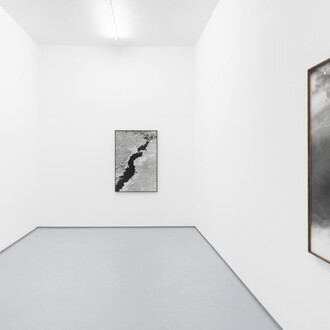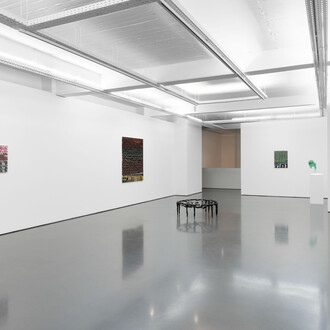Galeria Vera Cortês presents The Broken Shell of the Hermit Crab, group show with works by Dora Budor, Jan Kiefer, Augustas Serapinas and Teresa Solar, curated by Samuel Leuenberger.
The title of the exhibition, The Broken Shell of the Hermit Crab, suggests a metaphorical space that needs simultaneously invasion and defense. The hermit crab uses empty snail shells or other hollow objects as a shelter for partial containment and protection of the body. And since their bodies are always changing and outgrowing their current habitat, the desire to conquer a new housing is a constant urge. The exhibition is bringing together the works of four international artists whose practices are driven by a conceptual approach to object making, bearing a strong interest in popular culture – notably a socially motivated and historicist research when constructing narratives. Thinking the behavior of the hermit crab as a conceptual starting point all four artists deconstruct cultural clichés and extrapolate a new understanding of the space they investigate. A new language is being applied for the space that is inhabited, where different bodies can navigate a multitude of different environments, physically as emotionally and spiritually. These conceptual spaces are defined by a set of economies based on a unique understanding of language, well-being and prosperity.
Dora Budor’s (*1984, HR) artistic practice is largely concerned with the subtexts and spaces of cinema, reimagining these narratives as ecological systems to be reworked and renewed. Inside the gallery space, Budor is presenting an ephemeral work in two spatial sequences, titled The Preserving Machine – Notes from the Environment. Following the installation The Preserving Machine exhibited at the Baltic Triennal earlier this year, Notes from the Environment are reflecting dislocated remains of the exhibition experience. One part, consisting of a layer of dust, is covering the floor of the exhibition space, and the other, which is made of window gels, is affecting all the incoming light in the office area. Both Notes lay at the core of creating the cinematic experience: the use of light and special effects to convey both time and mood. The dust, the same one that is used to age movie sets, made of diatomaceous earth (crushed fossilized shells), is adding a layer of prehistoric time to the exhibition. It spreads around the edges of the exhibition space and slowly through the visitors' movements invades the room while the yellow gels mounted on the windows suggest a setting of intense heat outdoors via its blurry, warm tint that is projected into the office space. When the Sick Rule The World, a larger series of photographs in which Budor collaborated with five different old-age prosthetics make-up artists (MUA) to produce film stills from a non-existing feature film, is a work that takes place outside the gallery space, acting as a prologue of the exhibition.
Jan Kiefer's (*1979, DE) works delve directly into the subtleties of the everyday, challenging the very matrix that makes-up the status quo of Western society. The behavior patterns resulting from this consumer society or the people's interaction with an indoctrinated belief system all create visual codes and connotations of an imaginary culture. In turn, these visual codes become the very commodities that define a generation. Kiefer poignantly mirrors these social patterns by deconstructing everyday objects and their associated mannerisms. His objects are in reality conceptual portraits of an unknown individual. For the exhibition, Kiefer has produced a series of new paintings depicting an all-over cross pattern, a religious symbol that is interweaved and prospectively transformed into an illusionistic flat design, reminiscent of the 20th century Dutch graphic artist M.C. Escher. Furthermore, two lit display boxes containing various paraphernalia like cheap perfumes, canned prosecco drinks or origami folded Euro bills construct another portrait of a blue-collar; they are hung next to a large stain-glass window in the shape of a cactus. There is an exoteric physicalness to Kiefer’s work that is referencing bygone art periods, but it's his intermixing of it with mundane objects that produce a feeling of familiarity and emotional introspection.
Augustas Serapinas' (*1990, LT) practice is invested in recomposing socially engaged spaces in order to foreground and problematize the assumptions that shape them. By inverting the customary functions of objects and spatiality, Serapinas toys with the possibilities of the encounter - with art and with the social relations it engenders, as a phenomenon and an opportunity. Often Serapinas' work starts without an object but with the question what new connections can be made and what spaces, specifically the ones hidden from plain sight, can be excavated and rendered visible. Backrooms of museums, storage spaces or technical equipment rooms become signifiers of human (inter-)action that often stays unnoticed. In this exhibition, Serapinas is presenting a reclaimed wooden (house) corner taken from a slowly disappearing Lithuanian typology of sheds that were popular in the rural landscape of the 1920s & 30s. Like cross-sections, the artist appropriates entire facades or windows and other architectural elements like the aforementioned corner and points to a vanishing historical building tradition while illustrating the consequences of an economic free trade and how spaces naturally become obsolete. Another work in the exhibition consists of a reclaimed window in a frame belonging to the same type of disappearing house. On its glassy surface, a stained-glass window painter has drawn the very scene that the former occupant of the house could view from it, before the building and its sight were demolished.
Teresa Solar's (*1985, ES) work expands and contracts; it oscillates between sculpting and drawing in space and it always ends up in an immersive act of transformation – interpreting stories, transforming materials or translating tensions she deliberately invokes. Solar's imagery is narrative driven, and her creative process often begins by uncovering a story that brings together complex worlds that either draw from literary works of fiction, natural history or more terrestrial narratives that are close to her personal life. For the exhibition, she revisits a central figure: Nut, the Goddess of the Night in Ancient Egypt, a celestial creature that connects to her family history. The elongated figure, a gigantic 12-meter long structure is laying on its side on the floor and involuntarily blocks the visitors' passage from one side of the gallery to the other.
Slightly propped off the ground, she appears to be resting her body while, on top of her hip, a tiny sculpture of a tiger is resting. The little tiger has been stretched in its physical volume, animating the toy body, in a weird, half-accordion manner, to life. A third work that Solar specifically made for the exhibition is called Pipeline: junction, a vertical structure made of two circular steel pipes balancing around a fleshy colored ceramic work. The squeezed and deformed ceramic structure in the middle of the threesome acts as a hinge for the two pipes that look like they strangely escaped from two contradictory worlds, that of an industrial pipe factory or of a large theme park.















